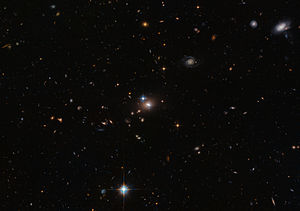Twin Quasar
| The Twin Quasar Q0957+561 | |
|---|---|

The Twin Quasar QSO 0957+561, which lies 7.8 billion light-years from Earth, is seen right in the center of this picture.
|
|
| Observation data (Epoch J2000) | |
| Constellation | Ursa Major |
| Right ascension | 10h 01m 20.99s |
| Declination | +55° 53′ 56.5″ |
| Redshift | 1.413 |
| Distance | 7,800,000,000 ly (2,400,000,000 pc) |
| Type | Rad |
| Apparent dimensions (V) | 6" distance |
| Apparent magnitude (V) | 16.7 |
| Other designations | |
| Twin Quasar, Double Quasar, Twin QSO, QSO 0957+561, Q0957+561, SBS 0957+561, TXS 0957+561, 8C 0958+561, PGC 2518326, A: USNO-A2 1425-7427021 B:USNO-A2 1425-7427023 | |
| See also: Quasar, List of quasars | |
The Twin Quasar (Twin QSO or Double Quasar or Old Faithful, also known as SBS 0957+561, TXS 0957+561, Q0957+561 or QSO 0957+561 A/B), was discovered in 1979 and was the first identified gravitationally lensed object. It is a quasar that appears as two images, a result from gravitational lensing caused by the galaxy YGKOW G1 that is located in the line of sight between Earth and the quasar.
QSO 0957+561 A (SBS 0957+561 A) and QSO 0957+561 B (SBS 0957+561 B) are the two components of a double-imaged quasar, meaning that an intervening mass concentration between Earth and the quasar bends light so that two images of the quasar appear in the sky. This is known as gravitational lensing, and is a consequence of Einsteinian warped space-time. The quasar lies at redshift z = 1.41 (8.7 billion ly), while the lensing galaxy lies at redshift z = 0.355 (3.7 billion ly). The lensing galaxy with apparent dimension of 0.42×0.22 arcminutes lies almost in line with the B image, lying 1 arcsecond off. The quasar lies 10 arcminutes north of NGC 3079, in the constellation Ursa Major. The astronomical data services SIMBAD and NASA/IPAC Extragalactic Database (NED) list several other names for this system.
The Twin Quasar's two images are separated by 6 arcseconds. Both images have an apparent magnitude of 17, with the A component having 16.7 and the B component having 16.5. There is a 417 ± 3 day time lag between the two images.
The lensing galaxy, YGKOW G1 (sometimes called G1 or Q0957+561 G1), is a giant elliptical (type cD) lying within a cluster of galaxies that also contribute to the lensing.
...
Wikipedia
